Briefly about the Company
- The company was established by Johannes Gutmann in 1988, in Austria. The entrepreneur’s primary goal was not to make as much money as possible, but to create good jobs for himself and for others.
- He wanted the jobs to be satisfying, the products – healthy and enjoyable, the business – environmentally friendly and sustainable.
- The business was successful, having a turnover of more than EUR 100,000 in the first year. The company grew quickly, spreading to the markets of neighboring countries.
- Nowadays, the company deals mainly in organic spices and teas. Its largest operations are in Germany, Austria, Czech Republic, Italy,
France, and Switzerland; it is also represented in many other countries. It had a turnover of EUR 27.4 million, plus EUR 6.0 million from Czech subsidiary, in the financial year 2012-2013 (Sternad, 2014).
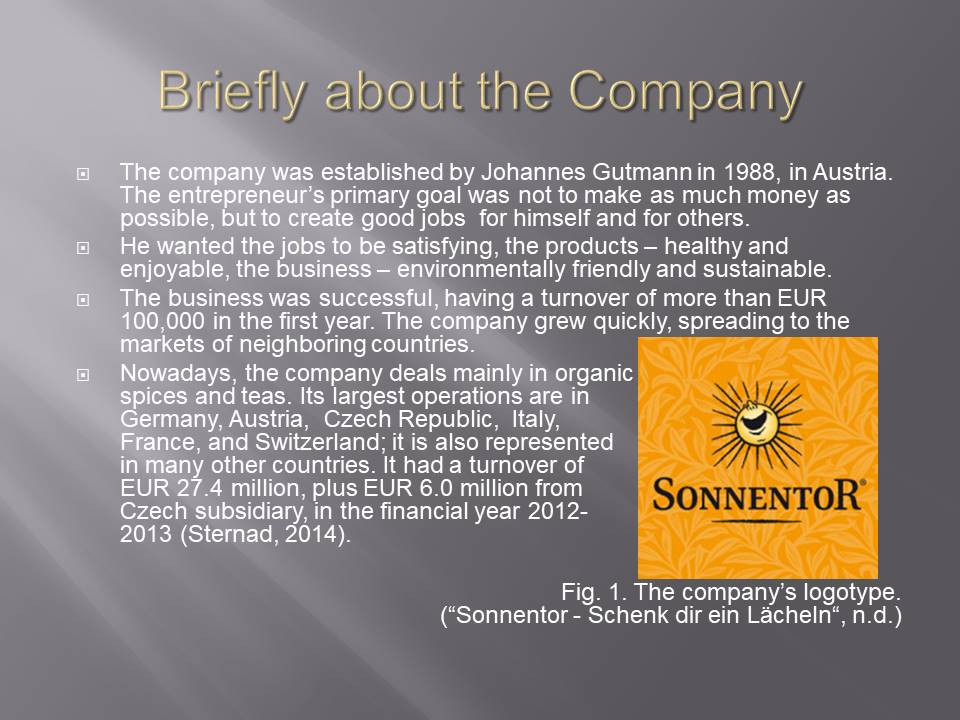
Current HR Strategies
The company hires people not only on the basis of their qualification; the applicant’s social competence is considered to be of no less importance than professional knowledge and skills.
Employees are also evaluated on the basis of their correspondence to the company’s values and organizational culture.
People without preceding experience in the industry are given preference; according to Gutmann, those who have experience in the field tend to be conservative, trying to utilize standard approaches and saying that “this is the way it has always been done” (Sternad, 2014, p. 12); apparently, this would be likely to destroy the company’s peculiarities which made it so successful.
The company receives a large number of job applications weekly.
After hiring an employee, the new worker undergoes a special training program.
During the first six weeks, the new employees are required to work in each part of the company, in order to learn more about the business and understand the whole process.
They also accompany the more experienced “Sonnentor “workers to meetings with clients, suppliers, and others.
The company provides its employees with the opportunity for personal growth, allowing the workers to visit various seminars, on personal development and health issues in particular.
Much responsibility is delegated to the staff; they are in charge of all the daily business activities, whereas Gutmann concentrates on the vision and the company’s general strategy (Sternad, 2014).
As of 2013, the company employed nearly 180 people (not including approximately 50 freelancers) in Germany, and 80 more employees in the Czech Republic, which deals with all the markets in Eastern and Central Europe.
The company also has a large number of women in key positions. It is stated that nearly 57% of the team leaders of the departments were females.
The workers are permitted to be employed according to a part-time model, which allows them to preserve a beneficent balance between their job and private life.
The enterprise only has the annual fluctuation rate of 5%, and the average number of days off work due to diseases is approximately 5.5 days a year, which is, on the average, nearly twice less than in other companies in Austria (Sternad, 2014).
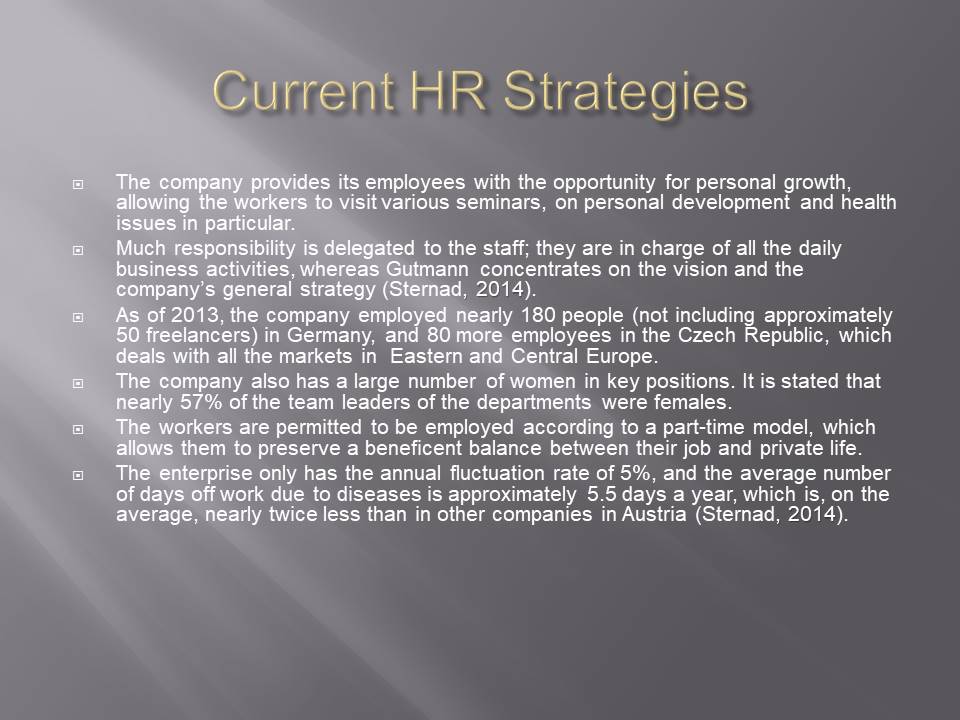
Current HR Strategy Assessment
On the whole, the company’s strategy has been successful so far, providing annual growth and development and allowing the business to spread to other countries.
The corporate values of the company “are based on sustainability, regional development, and maintaining regional identity”; nevertheless, the company exports approximately 75% of its products (Zillion International, n.d.). The company’s turnover growth rate is 10-20% percent annually.
It is claimed that the regional identity allows the company to remain so successful. The above-mentioned training that the employees receive, therefore, remains effective in preserving that identity so far and should be kept a part of the company’s future HR strategy.
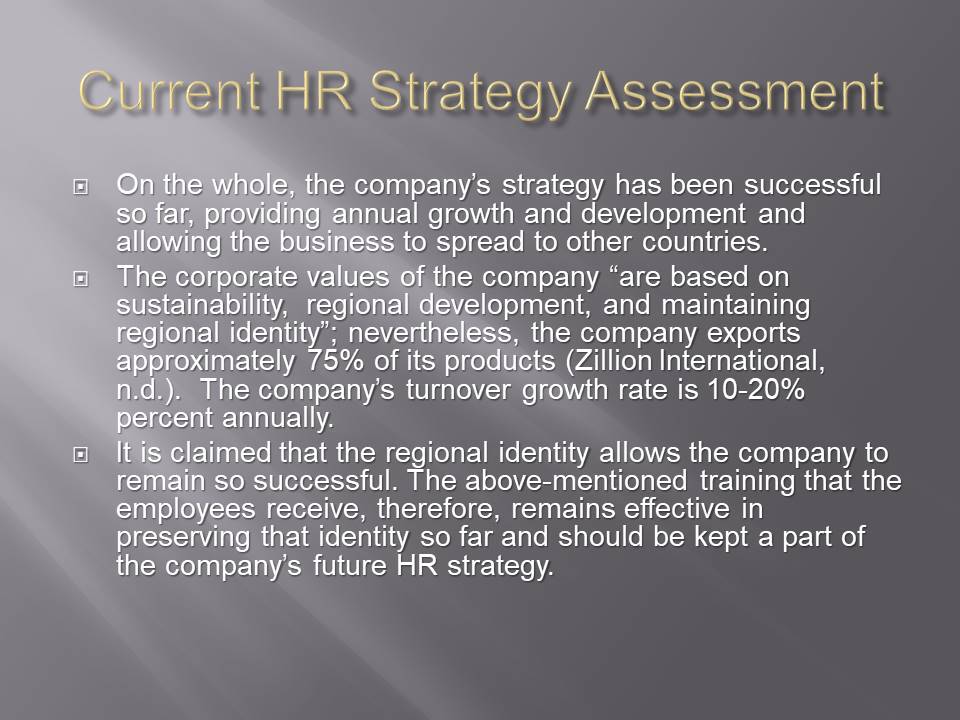
The Company’s SWOT Analysis
Strengths: Strong image among consumers, beneficial organizational culture, good business structure, reliable supply chain, efficient system of customer assessment, positive public image (Sternad, 2014; Zillion International, n.d.).
Weaknesses: Poor online presence, weak IT development rate, dependence on the company’s owner (Sternad, 2014; Zillion International, n.d.).
Opportunities: Geographic expansion, potential to broaden the production portfolio (Sternad, 2014; Zillion International, n.d.).
Threats: Johannes Gutmann, the leader of the company, might have to retire; unless he finds a successor with similar views, the company’s organizational culture might be threatened (Sternad, 2014).
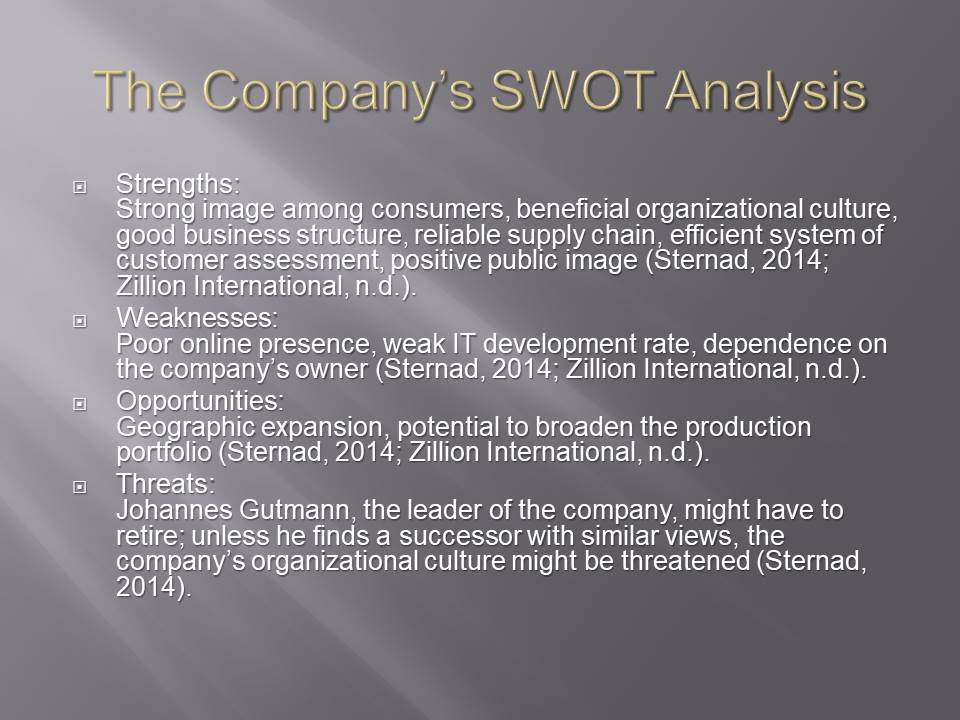
Future HR Strategy and the Company’s Strengths
It is crucial to retain the company’s strengths. To do that, it is important to have a proper HR strategy which would allow to hire new employees and keep the current ones “in line”.
The leadership of the company believes that the business’ organizational culture is strongly responsible for the enterprise’s success (Sternad, 2014; Zillion International, n.d.).
Therefore, it is necessary for “Sonnentor” to be able to preserve their organizational culture in any new locations where they open their shops or offices.
Thus, the future HR strategy should not rely on outsourcing. The future employees and partners should be focused on retaining the company’s image among the customers and other stakeholders.
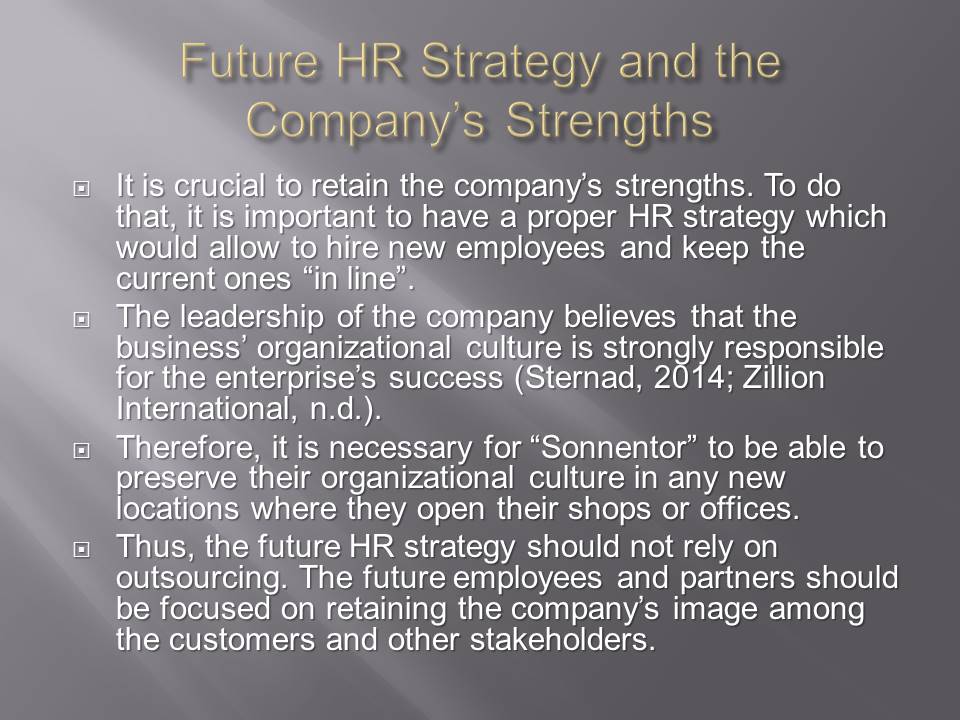
Addressing IT issues in HR planning
Notably, the company has rather weak online presence. Very little information about the company can be found on the Internet, even less – in English.
Informational technologies are paramount for every modern business (Ulrich & Brockbank, 2005). The IT technologies of “Sonnentor” are not well-developed, and need to be properly addressed.
Therefore, the future Human Capital planning strategies should also focus on recruiting IT specialists in the nearest future in order to establish greater online presence and further develop the internal functioning of the business.
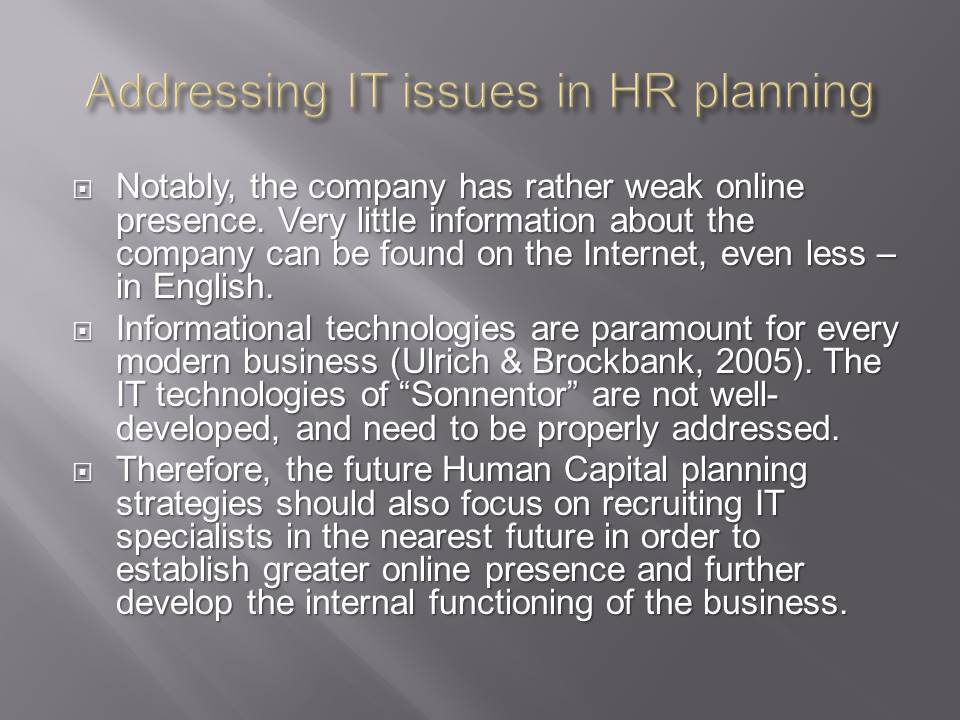
The Need for a Successor
Currently, Johannes Gutmann, the leader of the company, personally formulates the enterprise’s vision and strategy.
It is stated that he has not been able to find a person who would replace him and retain the business’ values and philosophy so far (Sternad, 2014, p. 14-15).
Therefore, in the next few years, it is also necessary to find a person who would be able to occupy the leader’s position in the company and keep its values intact.
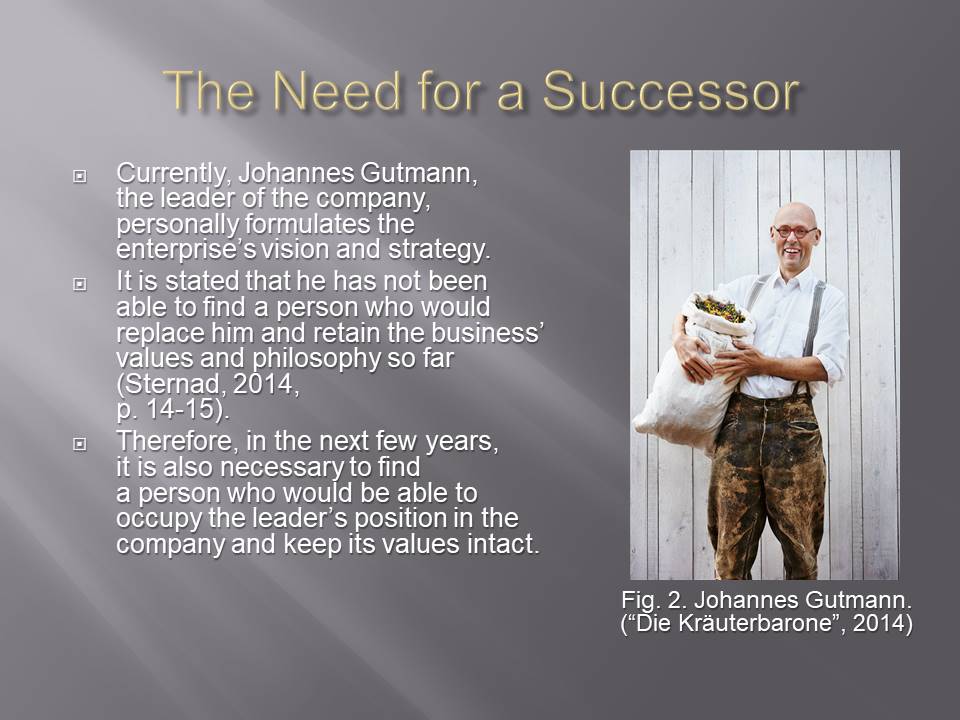
Conclusion – HR strategies for the future
The company currently has a strong HR recruitment and development strategy which allows it to maintain a beneficent organizational culture.
The future HR strategies should focus on the maintenance of the company’s organizational culture and other strengths, and addressing its few weaknesses.
The company should not rely on outsourcing and preserve its hiring and training practices.
Steps that need to be taken in the next five years:
- IT specialists should be hired in order to create a sufficient online presence and develop the company’s IT resources (1-1,5 years).
- Identifying the training needs of the prospective franchisees and developing respective training and involvement strategies is important for successful future growth via franchising. As the company is planning to grow via franchising, the program needs to be developed in the nearest future and maintained and assessed for the next five years; then further decisions might be required.
- A person who could replace the company’s leader should he retire needs to be found. It appears unlikely that Johannes Gutmann retires during that period, but the probability grows with each passing year, so the issue needs to be addressed in the next five years.
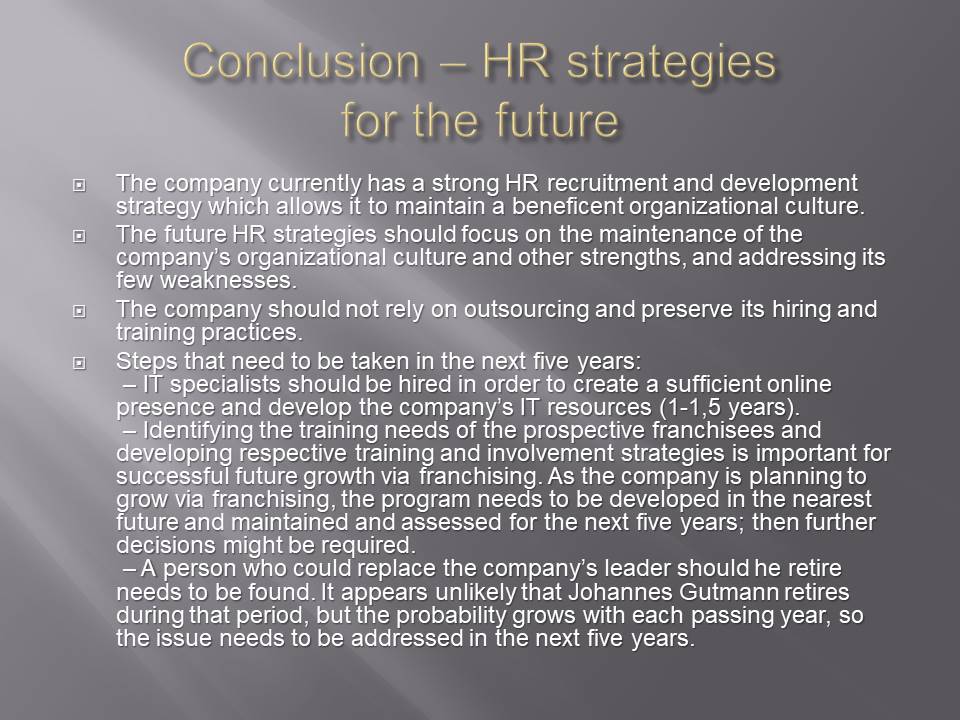
References
Die Kräuterbarone. (2014). Web.
Mathis, R. L., & Jackson, J. (2011). Human resources management (13th ed.). Mason, OH: South-Western Cengage Learning.
Sonnentor – Schenk dir ein Lächeln. (n.d.). Web.
Sternad, D. (2014). Organic growth at Sonnentor. Web.
Ulrich, D., & Brockbank, W. (2005). The HR value proposition. Boston, MA: Harvard Business School Press.
Zillion International. (n.d.). SonnentorKräuterhandelsGesmbH. Web.